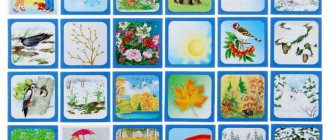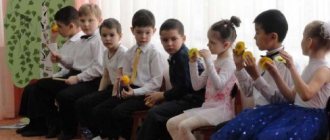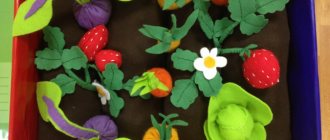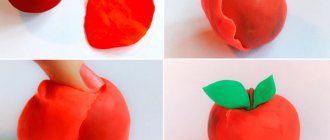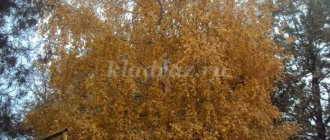Didactic game “Autumn Leaves” card index (junior group) on the topic
Didactic game for the development of sensorimotor skills in children 3-4 years old “Autumn Leaves”
Didactic tasks:
Learn to assemble a whole from parts; consolidate knowledge about color, size; develop visual perception, thinking, attention, logic; develop fine motor skills of the hands; develop speech.
Material: from colored cardboard (green, yellow, red, orange), cut out maple leaves, size (large - small), in pairs. Cut each leaf in half, leaving one pair uncut for sample.
Option 1. “Collect leaves”
Goal: to develop children's constructive skills, visual attention; develop thinking, attention, creative imagination.
Progress of the game:
The adult invites the child to assemble the leaves from the parts, noting that the leaves are of different colors and sizes.
- “A strong wind blew and the leaves scattered. Let's collect them."
Together with your child, fold the halves of the leaves to make whole ones.
Option 2. “Who has such a piece of paper?”
Purpose: to distinguish children's constructive skills, visual attention; consolidate knowledge of color (red, yellow, green, orange), size (large, small); develop speech, enrich vocabulary.
Progress of the game:
The adult gives the children one half of the cut pictures each, and keeps the remaining parts for themselves. He asks who should be given each of the halves in order to put together the whole pictures. When children choose their halves of autumn leaves, taking into account color and size, each child adds up the whole image and tells what kind of leaf he got (big red, small green, etc.)
The following options for playing with collected leaves.
Option 3. “Pick up the leaves”
Material: the same as in the previous game. Trees cut out of cardboard in yellow, red, orange, and green are added.
Goal: to teach children to distinguish colors (yellow, red, orange, green); teach to match leaves by color.
Progress of the game:
Invite the child to place the leaves on the trees of the corresponding color so that the leaves are the same color as the tree.
Option 4. “Big and small leaves”
Goal: to teach children to distinguish leaves by size, to consolidate the concepts: big - small.
Progress of the game:
The adult puts two leaves on the table and invites the child to put large leaves near the large leaf, and small ones near the small leaf.
Option 5. “Show me a piece of paper”
Goal: to teach children to show leaves according to the word denoting color. Strengthen children's ability to distinguish and name colors (green, yellow, red, orange).
Progress of the game:
The adult invites the child to show yellow leaves, red, green, orange.
Option 6. “Show me a piece of paper”
Goal: to teach children to show leaves by word indicating color and size. Strengthen children's ability to distinguish and name colors; consolidate the concepts of “big” and “small”.
Progress of the game:
The adult asks the child to find a piece of paper with a certain color and size.
- “Show me the big red leaf.”
- “Show me the little green leaf,” etc.
Option 7. “Name the leaf”
Goal: to teach children to name the color and size of a leaf. Strengthen children's ability to distinguish and name colors (green, yellow, red, orange) and sizes (big and small), develop speech.
Progress of the game:
The adult points to the piece of paper, and the child names what color and size.
Option 8. “Find a pair.” Goal: the ability to select pairs based on similar sensory attributes of color or size; develop visual perception. Progress of the game:
An adult invites the children to look at the leaves and asks them to name the color. Then he invites the children to pick up pairs of colored leaves.
Complication: take from 4 to 8 leaves.
Option 9. “Find the extra leaf”
Goal: to develop children's visual attention and thinking, logic.
Progress of the game:
The adult invites the child to choose an extra leaf. In front of the child, leaves are laid out, united by some characteristic, for example, by size or color; one of them does not have such a characteristic and is superfluous.
Option 10. “What has changed?” Goal: development of visual perception, memory, speech, enrichment of vocabulary. Progress of the game:
An adult lays out several pieces of paper on the table. The child is asked to close his eyes. An adult removes or swaps the leaves.
- "What changed?".
Invite your child to talk about the changes. Option 11. Outdoor game “1, 2, 3, collect a piece of paper!”
Objectives: to develop children's constructive skills, visual attention; develop thinking, consolidate knowledge about color and size, develop auditory and visual perception.
Progress of the game:
An adult gives children one half of the cut pictures. Children walk around the playground. At a signal, they scatter and run in any direction. At the signal “collect 1, 2, 3 leaves” they stand in pairs. (Music accompaniment is used).
Complication: change the pair each time.
"Autumn".
The north wind blew: “S-s-s-s” (blowing)
I blew all the leaves off the branches... (move your fingers and blow on them)
They flew, spun and sank to the ground (wave their arms in the air)
The rain began to patter on them
Drip-drip-drip, drip-drip-drip! (tap the fingers of your right hand on the palm of your left hand)
The hail pounded on them, (with a pinch of your right hand, tap on your left palm)
It pierced all the leaves. (knock the fist of your right hand on your left palm)
The snow then powdered (smooth movements of the hands back and forth)
He covered them with a blanket. (place your right palm on your left)
Didactic game “Which tree is the leaf from?” with your own hands
Didactic game “ Which tree is the leaf ?”
- be able to distinguish and name the leaves of familiar trees . ;
— to form children’s ideas about different types of trees , their characteristics, benefits for humans;
- develop children’s cognitive interest, attention, observation, ability to describe;
- activate children's vocabulary;
- cultivate curiosity and good feelings for nature.
Didactic material : Cards depicting 3 types of trees and leaves corresponding to these trees .
Progress of the game: Invite the child to connect the leaves with trees of the corresponding type and name them. Select leaves for each tree , name the tree and the leaf . For example: “This tree is called birch , and the leaf is birch ”).
Draw silhouettes of trees (birch, maple, oak)
Cut maple leaves from bright cardboard
Next, cut out the birch leaves
And also oak leaves . We glue Velcro onto the trees and leaves so that it is convenient to play and the leaves do not fly apart .
This is how the autumn trees . Maple.
Conversation “Which tree is the leaf from?” Goal: Continue to introduce children to trees and teach them to distinguish trees by their leaves. Develop mindfulness. Marina (teacher, do-it-yourself didactic game “Loto of Moods” for the Day of Good Emotions at MAAM. Games for the development of the emotional sphere in children are very exciting. Children play them with great pleasure. Didactic game “Which tree is the leaf from” with children of the preparatory group Goal: to form children's ideas about different types of trees, their characteristics, benefits for humans. To develop cognitive interest. Do-it-yourself didactic game “Laces” Research shows that due to the computerization of life in children, fine motor skills are reduced. Nowadays, many operations are performed. Do-it-yourself didactic game "Without play there is no, and cannot be, full-fledged mental development. A game is a huge bright window through which a child enters the spiritual world.
Source
Progress of the game
We saw him dressed in spring and summer, but in the fall all the shirts were ripped off the poor thing. ( Tree )
.
-Where do trees ? (In the forest, in the garden, in the park, along the roads, in the courtyards of houses, etc.)
Conversation about trees .
- What types of trees ? ( deciduous and coniferous )
.
Deciduous trees are those that have foliage ; all coniferous trees have needles called needles instead of leaves. In winter , deciduous trees fall off , while coniferous trees retain their needles.
- Name the deciduous trees .
— Name the coniferous trees .
(Magical, calm music sounds)
The breeze caught us
Moved to the autumn forest.
(children open their eyes, on the slide there is an autumn forest with birds singing, children with a teacher go to the palace)
- Guys! Let's imagine that we are in an autumn forest.
- How should you behave in the forest? (children's answers)
- Look, there are trees in front of you and leaves on them . And I also have leaves that have gotten lost and can’t find their tree .
- Would you like to help them?
- How can we do this? (children's answers)
-Well, then let's help the leaves . Choose any tree that you like and sit down near it. Now, guys, we need to choose a leader who will take the leaves out of the basket . (Using a counting rhyme, children choose a leader, who takes out one leaf at a time and asks : “ Which tree is the leaf ?”
.
The game continues until the leader runs out of all the leaves ).
"Game of Moods" Didactic game for preschool children Title: “Mood Game” Age: children 4-7 years old Purpose: development of communication skills and the emotional-volitional sphere of children Age: children. Conversation “Which tree is the leaf from?” Goal: Continue to introduce children to trees and teach them to distinguish trees by their leaves. Develop mindfulness. Marina (tutor,. Children's master class on painting with paints "Autumn leaf in a vase" - a print from a tree leaf. Master class "Autumn leaf in a vase" was carried out by children of the preparatory group for school in mixed media: appliqué and non-traditional. Didactic game "With what kind of tree is a leaf" with children of the preparatory group Goal: to form children's ideas about different types of trees, their characteristics, benefits for humans. To develop cognitive interest. Master class "Pentaminoshes - a logical game made of wood" Hello, dear colleagues! I want to share more with you one idea of making and using the puzzle game "Pentamino" This is for everyone. MK Didactic game "From which tree is the leaf?" - senior preschool age RelevanceThe natural world is rich and diverse. But intensive human economic activity constantly makes changes to it, disturbing it. Autumn walk " What tree is the leaf from? Observing the maple" Autumn walk "Which tree is the leaf from? Observing the maple" Goal: to continue getting to know the maple, highlighting its characteristic features.
Source
Progress of the lesson:
— The teacher lays out trees and offers to distribute the leaves on the trees by color .
— The teacher lays out trees and offers to distribute only large trees (only small ones)
.
— The teacher attaches leaves to the trees that do not match the given color and size and asks them to put things in order in the “confusion”
.
Source
Progress of the game:
Leaves lie scattered on the table. The teacher and the children compare the leaves , using the technique of overlay or application, by size and conclude that they are different: large and small. Then the teacher invites the children to match the leaves according to the color and size given by the teacher to the tree . Children place leaves in each section of the box.
Didactic game “What color is the profession?” Didactic game “What color is the profession?” Author: Svetlana Aleksandrovna Skovorodnikova, teacher of the 1st qualification category of MDOBU.
Didactic game for children of the senior group “Who makes what from wood?” Didactic game for children of the senior group “Who makes what from wood?” Goal: to expand children’s understanding of the different masters.
Presentation game “From which tree are the fruits” Objectives: clarifying children’s ideas about trees and their fruits; expansion and activation of the dictionary on the topic; formation of relative adjectives;
Didactic game “Which tree is the fruit from?” I bring to your attention a game for preschoolers. This game will help educators and parents consolidate children's knowledge about fruit trees and. Didactic guide “From which tree did the leaf fall?” Didactic guide “From which tree did the leaf fall?” The game is intended for children 3-4 years old. Purpose of the game: to develop visual attention. Didactic game “Seasons” with the production of felt wood Felt tree Didactic game Seasons. Goal: to consolidate children’s knowledge and ideas about the characteristics of each of the four.
Interactive game “Which tree is the leaf from” Interactive game for preschool children “From which tree is the leaf” Purpose of the game: to ensure the development of children’s ability to use tools.
Summary of an autumn walk “What tree is this leaf from?” Autumn walk “Which tree is the leaf from?” Author: teacher Lukinova S. Yu. Purpose: to continue acquaintance with maple, highlighting the characteristic ones. Master class on making a tree of happiness, a tree of wishes “Topiary” The last month of autumn has arrived, the rains have become more frequent, the temperature has dropped, people have warmed themselves. And how good it was in the summer - sun, sea, beauty.
Source
"Autumn"
The sun is already barely warm; (we spread our fingers on both hands and connect
palms together, then join fingers)
Migratory birds have flown south; (we wave our arms like wings)
The trees are bare, the fields are deserted, (we raise our hands)
The first snow covered the ground. (smoothly lower the handles down)
The river is covered with ice in November - (we squeeze our hands into a lock)
It's late autumn in the yard. (we spread our hands in front of us)
Didactic game “Which tree is the leaf from”
Zaykova Lidiya Olegovna
Didactic game “From which tree is the leaf”
Didactic game “From
which tree is the leaf ” .
Didactic game “ Which tree is the leaf ”
aimed at developing attention, observation, visual perception of color and size of an object.
The game is intended for individual work and joint activities of the child and the teacher.
The goal is to learn to distinguish an object by color (green, red, yellow)
.
- introduce children to the concept of “Value”
, learn to distribute objects based on size
(less, more, same)
.
— activate vocabulary on the topic: “yellow”
,
“green”
,
“red”
,
“
tree ” ,
“
leaf ” ,
“big”
,
“small”
.
— to develop children’s desire to take part in collective discussion, to develop the child’s desire to communicate and interact with the teacher and peers, to develop perseverance and concentration.
-instill respect and care for the environment.
Trees and leaves cut out of felt of a certain size and color (Yellow, green, red; large, small)
.
Didactic game “Which tree is the leaf from”
Natalya Averyanova
Didactic game “Which tree is the leaf from”
Didactic game “ Which tree is the leaf ”
.
Goal: to consolidate children’s knowledge of the names of trees , to attack the concepts of coniferous and deciduous , to promote the development of the ability to recognize plants by leaf .
Progress of the game: Show the children leaves from the trees and invite them to find out which tree they come from and find evidence (similarity)
with
leaves on a tree having a variety of shapes.
Equipment: subject pictures of leaves and trees .
